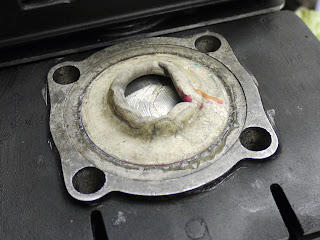 |
| Aircooled RD350 engine, late model electronic ignition |
Take the head off and...
 |
| Wössner RD350 two-stroke piston - work of art |
 |
| Modified RD350 cylinder head with a 12.5mm squishband |
Now the 2.2mm gap could quite well be intentional, as these heads could have been fitted to a race engine, which was running both without a basegasket and had the cylinder itself shortened by the height of the headgasket relieve. Yet this is not an excuse for machining the head too small and also for the headgasket.
 |
| Headgasket 1.35mm thick |
 |
| A stock RD350 head and combustion chamber (for comparison) |
Now here are two schools of thought. If you machine a very steep angle into the head (as seen in the picture above) the mixture will travel to the spark plug without being compressed overly much. It will do so, but not in a very fast way (still heaps faster than stock, but you get the idea!) Now if you used a very shallow angle, let's say around the 3 to 5 degree mark, the charge would be pre-compressed, heated up and would burn a lot faster, because it has already picked up a lot more speed.
There's many ways to actually measure the distance from piston crown to the roof depending on the size of the gap. In this particular case the distance was too big to use solder or twisted strands of solder, so I had to resort to some sort of clay in order to get the cylinder heads in the right ball-park to start with.
In order to make your actual measurement, the engine has to be reassembled, in this case meaning that the heads had to reinstalled and torqued to spec. (20Nm) Then the engine is turned over until the clay hits the cylinder head, everything is removed and the crank is turned until it reaches TDC. Now the height of the protruding clay is measured as this defines the amount of material to be removed from the head.
The cylinder head is installed on the lathe adapter in order to be machined.
As I am using an almost seventy year old lathe, DRO's are a no-go. So I had to restort to an ARO (analogue readout, aka. a dial-indicator) in order to only take off the required 1.1mm on the left and 1.2mm on the right cylinder.
As it turned out after a few revolutions, not only was the cylinder's squishband machined too wide, the cylinder head had also been tilted somewhat during the operation and as such wasn't perfectly perpendicular to the piston crown and sparkplug.
Last order of the day was to cc the actual combustion chamber by filling a graduated vessel with water. (In this case to the 600ml-mark.) The next step was to form a clay mould of the combustion chamber and then drop this in the bowl and measure the extra milliletres with a syringe, which came out at a spot-on perfect 30cc.









No comments:
Post a Comment